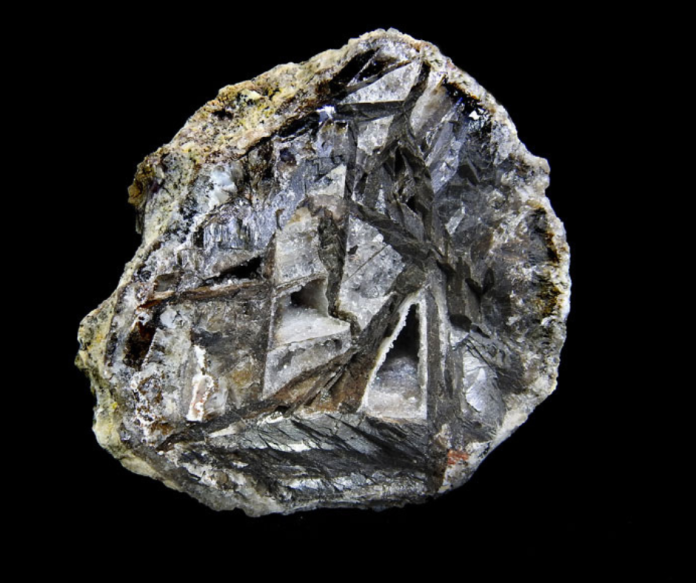
Las Choyas geodes are arguably the most popular, attainable, and collectible geodes available to geode enthusiasts. Geodes are popular no matter what the type. It’s hard to resist the mystery and challenge of what’s inside these rather plain-looking round rocks.
These Mexican geodes are different than their cousins, Trancas geodes. They are found in one small area just slightly north and east of Chihuahua City and are known in the trade as “Mexican Coconuts.” Collectible in this case does not mean field collectible as production is pretty much confined to one area owned by one family.
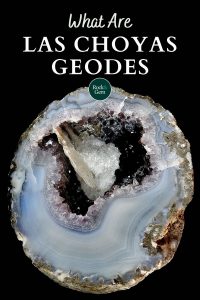
Unlike giant geodes, Las Choyas geodes for sale in rock shops and gem and mineral shows are between 2.5 and 3.5 inches in diameter although they can range up to six inches in diameter. Almost all are spherical in shape thus affirming our concept of what shape a geode should have.
Because the opportunity for field collecting is not available to the general public, most hobbyists will usually only have a few Las Choyas geodes in their collection.
The word geode comes from Ancient Greek and means “earthlike.” For the metaphysical believer, geodes, like Las Choyas geodes, are said to bring flow, harmony and resilience to the bearer.
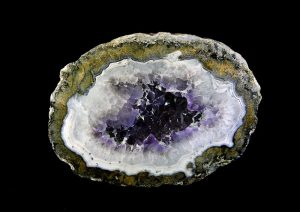
How They Are Formed
Unlike the famous Keokuk geodes that form in a sedimentary environment, Las Choyas geodes form in an igneous environment. This environment comes about as a result of a volcanic eruption producing an ash flow that contains bubbles that are trapped in the rhyolitic tuff rock formation when it solidifies.
These hollows in the rock provide the chamber where the mineral-rich fluids flow to start the process of geode formation. The total process may take millions of years and involves a complex series of geological events that ultimately yield these spectacular geodes.
The actual process of growth and development of these Las Choyas geodes is complex. Chalcedony rind formation is common, but it is not unique. In some of these geodes, siderite (FeCO3) forms the rind.
While quartz (SiO2) and calcite (CaCO3) are the most common minerals, 18 different minerals have been identified in Las Choyas geodes. Most of these minerals are very rare with a few only found using a scanning electron microscope!
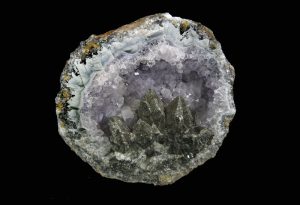
Minerals Commonly Found in Las Choyas Geodes
This list contains the minerals that the geode hobbyist might visibly encounter in their Las Choyas collection. The remaining minerals found in the Las Choyas geodes are either too small or rare that they will not be encountered by the geode hobbyist.
Las Choyas geodes can be hollow, semi-hollow, or completely filled and solid.
- Quartz (SiO2) may be found in the chalcedony rind, as a distinct band of crystals around the cavity, as a drusy layer, or as an over-growth on other minerals. The crystals are clear, smoky or amethyst.
- Calcite (CaCO3) may appear in different crystal forms such as pseudocubic, dogtooth, nailhead, rhombic, and sheets.
- Siderite (FeCO3) forms the rim in some of the Las Choyas geodes as well as appearing in the cavity.
- Goethite (HFeO2) appears as small black needles with chisel-like terminations in these geodes.
- Hematite (Fe2O3) appears as small black, brown, or red spheres sometimes on or included in quartz.
- Mordenite [(Ca, Na2, K2) Al2Si10O24.7H2O] forms a mat of white fibers and may fill the cavity of the geode.
- Selenite (CaSO4.2H2O) This crystal form of gypsum may appear as small clear tabular crystals.
- Pyrolusite (MnO2) This manganese oxide forms dendritic crystals that can grow around and on the quartz and calcite crystals.
- Ramsdellite (MnO2) This manganese oxide forms small black crystal groups with needle-like crystal terminations.
- Todorokite [(Mn, Ca, Mg) Mn3O7H2)] forms black mats of fibrous crystals.
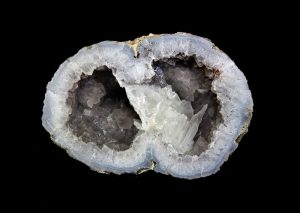
Mining Las Choyas Geodes
Las Choyas geodes are mined in a desolate area of the Chihuahuan desert. Mining involves extreme working conditions and very hard labor. The geode-bearing zone tips down from the surface at a 10-degree angle.
This means that as each area is exhausted of geodes, one has to go deeper underground. Going underground in this formation means drilling and hand-finishing a three-foot diameter hole through rhyolitic ash tuff rock.
After reaching the geode-bearing zone, miners must carve out open areas to remove the geodes using picks and hand geology hammers. The depth where the geodes are mined is now over 125 feet below the surface.
About 80% of the mined geodes turn out to be solid. While not as valuable as the hollow ones, they do have a use in the lapidary trade as material for cabochon jewelry and decorative objects such as bookends.
This story about Las Choyas geodes previously appeared in Rock & Gem magazine. Click here to subscribe. Story by Richard Gross.















